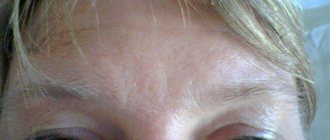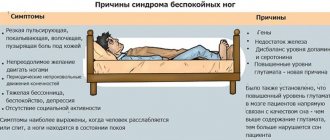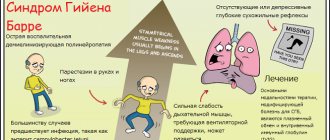Causes
The neurovegetative system carries out autonomous (without the participation of the will and control of the person himself) life processes:
- air circulation in the lungs;
- secretion of gastric juice and bile;
- regulation of tone in blood vessels;
- heartbeat, etc.
When the functioning of these systems is disrupted, communication between organs slows down or has a “fragmentary” character, which causes astheno-vegetative syndrome. That is, pain in the heart, an attack of suffocation or other “malfunctions” of the body may occur.
The very causes of disturbances in the autonomic system are explained by neuropathologies (hereditary, congenital or acquired) and deficiency of elements (potassium, magnesium, etc.) that contribute to the normal functioning of the nervous system.
Astheno-vegetative disease is often observed in adolescents. During adolescence, when a powerful restructuring of the hormonal system occurs, the body is exhausted or cannot cope with those pathologies that already began in an earlier period:
- trauma to the child, physical and psychological, especially an unfavorable moral environment in the family or in the classroom;
- consequences of infectious diseases (disorders of the endocrine and other systems, weakened immunity and liver or kidney function after long-term use of antibiotics).
The causes of the syndrome may be malnutrition:
- the body is supplied with an insufficient amount of vitamins and minerals necessary to compensate for the rapid development of organs;
- violation of metabolic processes - healthy foods are simply not absorbed;
- abuse of carbonated drinks, which “wash out” beneficial substances, as well as too spicy foods (chips, crackers) and fast food.
Common causes of the development of astheno-vegetative syndrome are violation of the daily routine, mental fatigue and physical inactivity. The child should sleep a lot, walk in the fresh air, not sit at a desk or computer, and play sports.
Symptoms
The phenomenon of asthenovegetative syndrome occurs in both children and adults. The main symptoms are the same for everyone:
- minor physical activity is accompanied by rapid heartbeat;
- digestive system dysfunction;
- chronic state of weakness and fatigue;
- profuse sweating;
- dull headache;
- frequent darkening of the eyes and fainting.
People with vegetative syndrome usually have cold extremities, and fainting may occur in a stuffy room.
In adolescents, in their puberty, even without this illness, their character deteriorates. But astheno-vegetative syndrome further aggravates the picture:
- causeless irritation quickly gives way to laughter;
- during a fit of rage, the child, clearly suffocating, gasps for air;
- may withdraw into himself for several days, strongly experiencing some emotions, while the teenager cannot hold one position for a long time, fidgets all the time, twitches his shoulders or mouth;
- lack of interests;
- absent-mindedness and memory problems.
Astheno-vegetative syndrome is characterized by physical symptoms in children:
- the child often complains of abdominal pain, headache or heart pain;
- cannot fall asleep for a long time, sometimes insomnia can torment several days in a row;
- slow physical reaction.
Unfortunately, the symptoms of asthenovegetative syndrome do not appear immediately. Neurological diseases have a long incubation period. Children are often brought to doctors with already significant autonomic disorders. Therefore, you need to monitor the child’s nutrition and daily routine, his physical and mental stress from birth.
Symptoms
The first symptoms of disorders of the nervous system are practically invisible; they are attributed to some natural causes. For many adults, fatigue and depression are justified by workload, temporary setbacks and problems. During the entire period of the disease, many abnormalities occur, both mental and physical, which do not immediately add up to the overall picture of the disease.
The patient is concerned about fatigue, fatigue, especially during intellectual stress. Memory lapses, difficulties in formulating your thoughts, impaired concentration, decreased productivity.
The main somatic symptoms include profuse sweating, headaches, nausea and vomiting, blurred vision, hypertensive crisis, stomach pain, bowel dysfunction, slow functioning of the vascular system, which is expressed in the form of cold extremities.
Somato-vegetative symptoms can also include a nervous urge to go to the toilet, which may be accompanied by cutting pain in the genitals.
It often happens that patients complain of symptoms that manifest themselves in the form of mixed vegetative-vascular dystonia or causeless pressure surges. Once upon a time, according to doctors, this crisis was associated with disruption of the cardiovascular system, but not so long ago this assumption was refuted. It has been proven that mixed-type vegetative-vascular dystonia syndrome is associated with the functioning of the neuro-vegetative department, therefore in ICD-10 it is classified as a symptom of neurotic disorders.
Autonomic dysfunction syndrome affects not only the adult population, but also newborns, children and adolescents. In the latter, it appears especially often, since during puberty there is a total restructuring of hormonal levels, which may not pass without a trace. Asthenic syndrome in adolescents is expressed through symptoms such as frequent mood swings, lack of interest in any activity, high irritability, isolation, and chaotic body movements. Mixed type vegetative-vascular dystonia syndrome affects adolescents more often than the adult population.
In children and newborns, due to the mobile nervous system, somato-vegetative symptoms appear immediately with mental ones; restlessness and hyperexcitability are accompanied by sharp abdominal pain, insomnia, and headaches.
Astheno-vegetative syndrome, like many neuropsychiatric disorders, progresses over a long time, remaining almost unnoticed in the first stages. Because of this, patients whose symptoms are pronounced and prevent them from leading a normal life turn to specialists. To prevent the development of the disease, it is necessary to understand its cause.
Treatment
If there is a suspicion of an astheno-vegetative disease, even when mild symptoms are observed, children are first shown to a pediatrician. After a general examination, the doctor will decide whether to refer the child to a psychiatrist or neurologist.
Treatment of children with astheno-vegetative syndrome is rarely carried out using potent drugs or antidepressants. If there are no serious congenital or acquired neurological pathologies, non-drug therapy usually helps:
- A diet is prescribed. Control over proper nutrition includes eliminating unhealthy drinks and foods and providing children with foods rich in potassium and magnesium (dried fruits, buckwheat, millet, nuts, beans, cocoa), as well as B vitamins (sea fish, liver, chicken eggs, whole grain bread, sour milk, cabbage). Children should not be allowed to drink strong black tea and especially coffee. If a child wakes up very poorly in the morning and finds it difficult to concentrate on school, it is permissible to brew ginseng root or add a few drops of eleutherococcus to green tea.
- Use of herbs. Doctors try to prescribe treatment for children with astheno-vegetative syndrome without antidepressants. Sometimes it is advised to take a course of nootropic drugs of plant origin (for example, glycine). But in most cases, herbal medicine is sufficient. Before going to bed, brew valerian root, motherwort or mint. It is recommended to drink herbal tea with honey. After such a home remedy, children sleep soundly and healthy.
- Aromatherapy. Treatment with this method is excellent not only for adult patients, but also for children. A little essential oil that has a calming effect is added to a warm bath: rose, bergamot, jasmine, sage, sandalwood.
Signs and symptoms
The symptoms of astheno-vegetative syndrome are numerous and vary for each person. They are caused by ineffective or unbalanced efferent signals sent through both systems. Basic:
- Anhidrosis;
- Anxiety;
- Blurred or double vision;
- Bowel incontinence;
- Constipation;
- Dizziness;
- Difficulty swallowing;
- Exercise intolerance;
- Chronic fatigue;
- Insomnia;
- Low blood pressure;
- Orthostatic hypotension;
- Fainting;
- Tachycardia;
- Tunnel vision;
- Urinary incontinence or retention;
- Weakness.
Associated disorders
Autonomic asthenia syndrome is an independent disease that is included in the ICD-10 list. But any disorder does not go away without a trace; it rarely happens that a disease not detected in time does not provoke the development of new abnormalities.
Asthenic syndrome can slowly, but still progress. Many violations on the part of the affected systems become the cause of new ailments. Some consider these deviations as symptoms of astheno-vegetative syndrome, some consider them consequences, separate disorders.
For example, women often experience irritation syndrome. Many visits to the gynecologist do not always give results; not all specialists are able to determine the true cause of pain or adhesions, because irritative syndrome is quite rare, and some doctors do not attach importance to it.
Visceral syndrome causes stool failure, abdominal pain, and impaired bile secretion. Many visceral symptoms are characteristic of a variety of diseases, which again complicates the diagnosis of a neurovegetative disorder. People do not always see the connection between the nervous system and other departments responsible for somato-vegetative (bodily) manifestations, to which the visceral department belongs.
Trophic syndrome is a deviation characterized by pain and muscle atrophy. This also includes deterioration in the condition of the hair and nail plates.
Vestibular syndrome is a somato-autonomic disorder characterized by unclear movements, impaired motor skills and coordination.
Causes
Astheno-vegetative syndrome may be associated with hereditary or degenerative neurological diseases (primary). Sometimes occurs due to damage to the ANS from an acquired disorder (secondary). The most common reasons:
- Alcoholism;
- Amyloidosis;
- Autoimmune diseases such as Sjögren's syndrome, systemic lupus erythematosus;
- Craniocervical instability;
- Diabetes;
- Eaton-Lambert, Ehlers-Danlos, Guillain-Barré syndromes;
- HIV AIDS;
- Lyme disease;
- Multiple sclerosis;
- Paraneoplastic syndrome;
- Parkinson's disease;
- Spinal cord injury;
- Surgery or injury involving nerves;
- Toxicity (vincristine).
If asthenovegetative syndrome is present along with fibromyalgia, chronic fatigue, irritable bowel syndrome, interstitial cystitis, there is an increased likelihood that it is the underlying pathogenesis.
Anxiety can sometimes manifest itself physically as symptoms that resemble the disorder. A thorough diagnosis is necessary to exclude physiological causes.
In cases where appropriate tests are performed and the findings do not correspond to any known disorder, a primary anxiety disorder should be considered. For such patients, the Anxiety Sensitivity Index has better predictability.
Mechanism
The autonomic nervous system is an integral part of the peripheral nervous system. It consists of two branches: sympathetic (SNS) and parasympathetic (PSNS). The SNS controls active responses such as increased heart rate and blood pressure.
Parasympathetic slows down heart contractions and promotes digestion. Symptoms usually arise from abnormal responses of the sympathetic or parasympathetic systems depending on the situation or environment.
Diagnostics
The diagnosis of astheno-vegetative syndrome depends on the overall function of three - cardiovascular, adrenergic, vasomotor. Diagnosis should include measurements of blood pressure, heart rate while lying down and after 3 minutes of standing.
The best way to make a diagnosis involves a series of tests. For example, examination of reflexes, measurement of vasomotor response (QSART, thermoregulation).
Additional examinations to determine the diagnosis:
- Ambulatory blood pressure, ECG monitoring;
- Hyperventilation test;
- Nerve biopsy for small fiber neuropathy;
- Quantitative reflex (QSART);
- Testing for orthostatic intolerance;
- Thermoregulatory test;
- Valsalva maneuver.
Investigations to determine the cause include:
- Evaluation for acute (intermittent) porphyria.
- Assessment of cerebrospinal fluid by lumbar puncture.
Treatment
Treatment of astheno-vegetative syndrome can be difficult. It consists of many symptoms, so treatment of individual symptomatic complaints often requires a combination of drug therapy.
For example, if autoimmune neuropathy occurs, then treatment is carried out with immunomodulatory therapy; if the cause is diabetes mellitus, it is important to control blood glucose levels.
Treatment may include H2 receptor inhibitors and antagonists, used to relieve digestive problems such as acid reflux.
Drugs for the treatment of genitourinary autonomic neuropathy: sildenafil (guanine monophosphate type 5 phosphodiesterase inhibitor).
Anticholinergic agents such as trihexyphenidyl and scopolamine are used to treat sweating. Subcutaneous injection of botulinum toxin type A is used in some cases.
Treatment of children
Watch the video: astheno-vegetative syndrome in children, what to do? Doctors' recommendations
Causes of the disease
Autonomic dystonia syndrome causes many disorders of the peripheral system and affects a variety of organs. Depending on the affected area, the causes that cause asthenic syndrome vary.
Among all the reasons, the main ones can be identified:
- mental overload;
- past infectious diseases;
- physical injuries, concussions, surgeries;
- psychological trauma;
- chronic diseases associated with brain activity, ensuring the overall functioning of the body;
- change of time zones, usual work schedule;
- unstable daily routine;
- poor nutrition.
Astheno-vegetative syndrome in children and newborns may be associated with abuse and excessive demands on the part of the older generation. Due to oxygen deficiency suffered during the birth period, an asthenic crisis occurs in infants.
An asthenic crisis can be the beginning of a pathology that is provoked by somato-vegetative or neurological disorders. With insufficient blood supply and brain damage, tumors, and traumatic brain injuries, many disturbances in the functioning of the body, including the neuro-autonomic department, can occur.
Often, asthenia is a consequence of renal and liver failure, diseases of the cardiovascular, excretory, respiratory systems, and infectious diseases that cause depletion of the body.
Since the autonomic system is responsible for the coordinated functioning of the entire body, respiratory function, regulation of vascular tone, and an asthenic crisis provokes disturbances in this system, it is necessary to begin treatment of the disorder when the first signs appear.
Forecast
The autonomic nervous system regulates the body's internal organs, such as heart rate, blood pressure, digestion, and body temperature. People with asthenovegetative syndrome have problems regulating one or more of these systems.
This leads to fainting, dizziness, fluctuations in blood pressure, and other symptoms.
The prognosis depends on several factors. People with chronic, progressive, generalized asthenoautonomic syndrome due to central nervous system degeneration such as Parkinson's disease or multiple system atrophy have a worse long-term prognosis.
The syndrome can be fatal due to pneumonia, acute respiratory failure, and sudden cardiac arrest.
Dysfunctions of the autonomic nervous system include astheno-vegetative syndrome. The pathology is associated with a disruption in the transport of impulses to cells from receptors. A failure can also be observed in the interaction of neurons in the peripheral and central nervous systems. Most patients with this diagnosis manage to manage with conservative treatment, which includes maintaining a proper daily routine and maintaining a healthy lifestyle. Drug therapy is used only in advanced cases.
The role of stress and developmental mechanisms
This syndrome can develop both acutely and chronically, developing over several months or even years. Constant stress leads to the depletion of resources, which simply do not have time to fully recover during a short rest period (in the evening after work), especially if stress factors are not eliminated and continue to have their harmful effects. Then the body cannot fully recover and rest, even if it is a long rest; medication correction is needed. Constantly exposed to chronic stress or acute, but very strong irritants, lead to disruption of the transmission of impulses and commands from the central part of the nervous system to the periphery. Due to the influence of stress, these signals are delayed, or are too hasty, distorted, or simply do not reach. As a result, the work of the spinal cord and their subordinates, the peripheral nerves, is unbalanced.
What is astheno-vegetative syndrome?
Astheno-vegetative syndrome manifests itself as chronic weakness and a number of other symptoms
Astheno-vegetative syndrome is usually called a disorder of the visceral nervous system. Due to this disease, there is a disruption in the transmission of nerve signals. Adults and children of different ages can encounter it. Most often, pathology worries adolescents during puberty.
The International Classification of Diseases contains information about disruption of the autonomic, that is, autonomic nervous system. In ICD-10, the syndrome is coded G90. Below it are listed unspecified ANS disorders.
The disease is usually classified according to severity. At an early stage, the pathology is accompanied by a feeling of weakness and exhaustion. In severe cases, the disorder leads to dangerous neurological abnormalities that greatly affect the patient's life.
Reasons for violation
Astheno-vegetative syndrome in adults and children can be caused by various reasons that negatively affect the functioning of the human body. These include the following unfavorable factors:
- Chronic lack of sleep.
- Experiencing stressful situations.
- Bad habits that a person has been addicted to for many years.
- Severe mental or physical fatigue.
- Lack of sleep and rest.
- Acute and chronic pathologies that disrupt the functioning of internal organs.
- Psychological trauma.
- Maintaining a sedentary lifestyle.
- Unhealthy eating.
All these factors contribute to the development of nonspecific symptoms, which are commonly defined as ABC.
Symptoms in children and adults
Darkening of the eyes may indicate the development of the disease
Astheno-vegetative syndrome can affect both adults and children. The child’s body tolerates this condition less well, so attempts should be made to stop the disease at the first signs of its appearance.
The following are the signs that occur in people with such an astheno-vegetative disease. Pathology is indicated by symptoms:
- Increased heart rate even with light exertion.
- Excessive sweating.
- Chronic weakness.
- Dull headaches.
- Disruption of the gastrointestinal tract.
- Darkening in the eyes.
People with the syndrome have constantly cold hands and feet. In a stuffy room, they may faint, which is also a characteristic condition for astheno-vegetative syndrome. This occurs in adults and children.
The course of a painful condition in a child or adolescent can be determined by the following signs:
- Lack of air in moments of rage.
- Unreasonable irritation followed by laughter.
- Lack of interest in anything.
- Absent-mindedness and poor memory.
- Closedness.
The disorder can develop with VSD (a designation for vegetative dystonia). Neurotic syndrome is often accompanied by symptoms that indicate physical illness. These include complaints of pain in the head and heart area, insomnia, and delayed reaction.
Etiology and clinical picture
Vegetative syndrome is a consequence of an imbalance of the autonomic system, one of the main regulators of the activity of all organs and systems of the body. The syndrome is not an independent disease, it is a complex of symptoms, each of which may indicate a separate disease.
The problem is that some organs and systems in the human body begin to overreact even to minor stimuli.
Causes of dysfunction:
- overload of the body with mental or physical stress;
- stress and psychological turmoil;
- constant difficult emotional background in the family or at work;
- sleep deficiency;
- frequent changes in climate and time zones;
- lack of work and rest schedule;
- physical inactivity.
Single stresses and overloads do not cause significant harm to the body, but if such shocks enter the system, the body begins to malfunction. People suffering from endocrine, neurological, infectious and cardiovascular diseases are at a particularly high risk of the occurrence and development of dysfunction. Most often, people weakened by chronic diseases suffer from autonomic disorders. Sometimes a hereditary factor and a lack of vitamins and minerals in the body play a role.
To determine the clinical picture, the patient is asked about his lifestyle, psychological state and mood, the presence of local symptoms is recorded (frequency, nature, localization of pain, sweating, tremors, etc.), signs of general pathological processes are identified, and, if necessary, prescribed laboratory and instrumental examinations. The patient may experience causeless phobias, depression, suffer from insomnia, mood swings, irritability, memory impairment, and dizziness.
Diagnostics
The diagnosis of the disease is carried out by a neurologist
ABC negatively affects the functioning of many systems of the human body. Therefore, diagnosing his condition is extremely important. It allows the doctor to correctly determine the diagnosis and prescribe adequate treatment to the patient.
When examining a patient with suspected astheno-vegetative disorder, the following methods are used:
- Anamnesis collection.
- Physical diagnosis.
- Instrumental diagnostics.
The last version of the study is used if the patient has independent pathologies that disrupt the functioning of internal organs and systems.
A neurologist examines a patient who exhibits severe symptoms of astheno-vegetative syndrome. He makes a diagnosis and expresses his opinion about the person’s current condition. In some cases, additional consultation with a psychiatrist and psychologist is required.
Somatic manifestations: pain, sleep problems, appetite
Various unpleasant and painful sensations from the body are common. Worries include drowsiness during the day or sleep disturbances at night, insomnia, shallow and intermittent sleep, a feeling of eternal chilliness or excessive sweating disproportionate to the temperature, fluctuations in pressure and pulse rate, pain in the heart area of a transient nature, a feeling of stuffiness or lack of air. The sensitivity of the skin and sensory organs may change - familiar irritants are felt very sharply, even to the point of pain.
Patients often complain of a dull, pressing headache that occurs due to exertion or an almost constant, starting in the morning, sharp reaction to the weather. The digestive system and bile secretion may suffer, resulting in pain in the side, near the navel or along the intestines. The nature of the pain is different each time, which distinguishes this condition from organic pathologies. Often the pain goes away after rest or a change of activity, a walk or a change of environment.
Such a condition requires consultation with a doctor not only in order to cure all unpleasant symptoms in a timely manner and return the person to duty. Often, asthenovegetative syndrome is the initial stage of serious neurological diseases, and their early recognition helps prevent complications.










